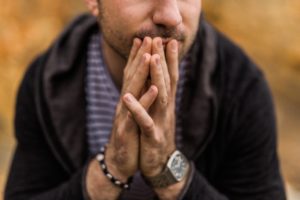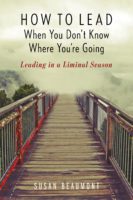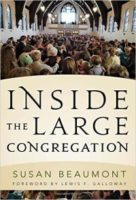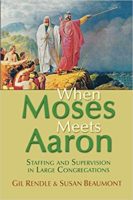
The beginning of the pandemic was overwhelming, but our focus was clear—figure out how to worship, connect, and teach in an online environment. The boundaries marking what we could not do provided clarity. Now, in-person engagement is returning and we face another kind of overwhelm—too many options. How do we make choices when some boundaries have been removed, but not everything is possible? To meet the needs of this season, we must help our leaders shift out of decision-making mode and into a discerning mindset.
Fresh ideas abound. The internet is full of advice about creating a hybrid ministry environment—tending to the needs of those who feel comfortable returning to in-person engagement while also meeting the needs of those who prefer online engagement. What old practices do we bring back and what do we release? What new practices do we layer in?
Our rational decision-making models may be too limiting for this season. We need processes that engage the Holy Spirit as a decision partner, because what needs to happen next may be larger than the limits of human imaginings. We need to be led by the future itself. Relying on past patterns of success will not serve us well.
Shifting to Discernment
The shift from decision making to discernment should feel natural in faith-based institutions. Sadly, many of us are disconnected from the ancient discernment practices that have grounded the Church for centuries.
Here are five important practices that can help strengthen the discernment muscles of your leadership body. These practices augment typical decision-making steps, inviting a soulful shift among your leaders.
Broaden your Focus. Decision making begins with a narrowly defined problem to be solved: “Should we resume our 8:30 AM traditional worship service now?” When an opportunity is framed narrowly it invites simple debate about the pros and cons of a single option: “Will enough people participate to warrant the investment of leadership effort? Do we have adequate space to ensure safety? Does our staff have capacity to support this worship venue?”
Shifting towards discernment requires a broader framing of the issue: “How have the worshipping needs of our community shifted during the pandemic? What practices will help people connect with God in the new environment? What shifts in worship venue or time do these concerns suggest?”
Broadening our focus slows down the decision-making process. A slower process may temporarily add to our feeling of overwhelm, but it also invites a more discerning stance. A broader framing of the issue opens us to consider nuanced options, possibilities beyond the limits of a problem-solving stance.
Framing the focus of your discernment may take more time than any other phase of the process. Your options for framing the challenge are limitless, and each option will take leaders down wildly different paths. Taking extra care in this early stage ensures that later dialogue is productive and relevant.
Ground your decision in guiding principles. A discernment process is grounded in guiding principles that are important to the discerning body and specific to the issue under consideration. The guiding principles create meaningful boundaries for subsequent conversation. A guiding principle may come from scripture, from the mission of your organization, from your core values, or from your religious tradition or denomination.
For example, before brainstorming possible options, a leadership body might agree on a statement like this: “Any viable option must promote the safety of the community, allow meaningful engagement of both the in-person and online communities, embrace our tradition of excellence in music and the arts, and honor our Reformed worship tradition.”
Shed ego and bias. Shedding involves naming and laying aside anything that might prevent the group from focusing on God’s will as the ultimate outcome in decision making. We name and release unhelpful biases and ego investments in outcomes. This occurs before we brainstorm or weigh possible options. We ask ourselves, “What needs to die in me/us for God’s gifts and direction to find room in this decision?”
A group considering changes in worship venues might acknowledge and release any assumption that in-person engagement is more authentic than online engagement. The pastor might release her ego investment in attaining pre-pandemic worship numbers. A board member might let go of his preference for the intimacy of worship in a chapel setting.
Listen for promptings of Spirit. A variety of practices exist for attending to the Holy Spirit’s movement in decision making. For example, a group might use the Ignatian practice of consolation/desolation:
- Sitting in prayer with each viable option, participants notice where they encounter the movement of consolation (feeling directed from beyond themselves, being drawn into community, feeling inspiration, feeling restored, balanced, refreshed, led, or energized).
- Alternately, group members may note the options that move them toward desolation (turning inward, being drawn toward negative feelings, feeling cut off from community, giving up on important values, feeling drained of energy).
- The group moves toward the options where they collectively feel consolation, leaning into and developing them further.
Other listening practices might include group Lectio Divina, the Prayer of Examen, Breath Prayer, Centering Prayer, Circles of Blessing or the Welcoming Prayer. Guidelines for Communal Discernment by Victoria Curtis is a helpful resource for those who want to expand their practice.
Test Decisions with Rest. Before drawing your discernment to a close, test any decision with rest. Before your choice is shared beyond the group making the decision, sit with your choice in stillness and prayer. Depending on the magnitude of the decision, your rest period may be a matter of minutes, days or even weeks. Sitting with the decision near to your hearts, ask yourselves if the decision reflects Holy Spirit wisdom.
At the end of the rest period, ask each member of the group to share any insights, spiritual nudging, or unaddressed longing that emerged in the silence. Ask each group member if they are still able to support the decision moving forward.
It is a new day and fresh practices born from our ancient traditions are required. Yes, discernment practices take time. Not every decision needs to be approached with a discerning mindset. However, when the ramifications of the decision are significant and the future cannot be intuited from the past, these five practices will help leaders let go of the past and discern the next chapter of your congregation’s life.
Susan Beaumont is a coach, educator, and consultant who has worked with hundreds of faith communities across the United States and Canada. Susan is known for working at the intersection of organizational health and spiritual vitality. She specializes in large church dynamics, staff team health, board development, and leadership during seasons of transition.
With both an M.B.A. and an M.Div., Susan blends business acumen with spiritual practice. She moves naturally between decision-making and discernment, connecting the soul of the leader with the soul of the institution. You can read more about her ministry at susanbeaumont.com.



